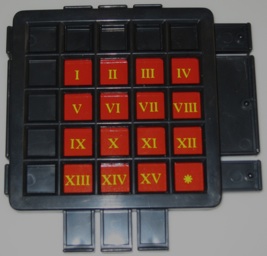
a.k.a. Rubik's Fifteen
Patented by E. Rubik 1984, copyright Matchbox 1990.
(plastic, 4.4 inches square by 3/8 inch thick)
The top side of the puzzle shown above has a 5 by 5 grid where the solved state has the numbers 1 through 16 (actually 1 through 15 and a star) arranged in row major order in the lower right 4 by 4 portion of the grid. There are three vertical plungers and three horizontal plungers. The vertical plungers can each be moved at any time to shift one of the middle three columns up or down one unit. The horizontal plungers are arranged with one for the top row, one for the bottom row, and a single one that simultaneously moves the middle three rows. In addition, the top and bottom plungers are constrained so that the top will only operate when all three vertical plungers are up, and the bottom will only operate when all three vertical plungers are down. The back of the tiles are yellow with numbers on them, and the back side of the puzzle has a 3 by 3 grid (centered in the puzzle) in which the solved state is to make a magic square of nine numbers (the sum of all rows, columns, and the two diagonals is the same). Jaap's Page presents a solution which can be used for both sides, and gives a table of all possible magic squares that can be made on the back. Tsukuda's Square and Uribock are similar puzzles with a different arrangement of plungers.
Further Reading
Jaap's Page, from: http://www.jaapsch.net/puzzles/rubik15.htm
McFarren's Page, from: http://www.geocities.com/abcmcfarren/math/r90/xvintro.htm
Wikipedia Magic Square Page, from: http://en.wikipedia.org/wiki/Magic_square
Rubik Patent, from: www.uspto.gov - patent no. 4,471,959